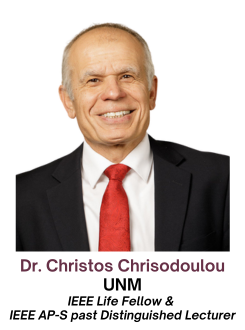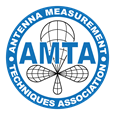2025 Regional Meeting - Abstracts & Speakers
Host for the 47th Annual Meeting and Symposium of the Antenna Measurement Techniques Association (AMTA)
Save the Date for the 47th Annual Meeting and Symposium of the Antenna Measurement Techniques Association (AMTA)! To be held at the Westin La Paloma Resort & Spa in Tucson, AZ, USA from November 2 – November 7, 2025.
Antennas, Machine Learning, and Emerging Space Technologies
As the demand for high-frequency satellite communications continues to rise, innovative solutions in propagation modeling, antenna design, and intelligent space systems are becoming increasingly critical. This presentation will delve into cutting-edge advancements in W/V band propagation modeling, leveraging machine learning to enhance accuracy and adaptability in future satellite networks.
We will explore the development of W/V band antennas, their role in satellite communications, and hypersonics. Additionally, the talk will highlight the application of machine learning in CubeSat detection and classification, improving situational awareness in orbit.
The discussion will also cover reconfigurable and deployable antennas for CubeSat missions, along with breakthroughs in space power beaming for energy transfer between space platforms.
On Selecting the Best-Suited Antenna Range for Measuring Antenna Radiated Performance
This lecture explores the importance of range performance, the approach to range selection, the need or not for shielding, the possibility of an indoor range and the type of range depending on the frequency and electrical size of the antenna under test. Most important, what is the expectation of the measurement, what is the parameter of interest. This discussion will lead to basic uncertainty analysis and the understanding of what is the allowable error in the measurement.
The Antenna Digital Twin – When Measurements and Simulations Unite
Antenna or OTA measurements are blind. Knowing the detailed implementation of the device under test is not needed to realize them. They even include all production tolerances that might impact performance. However, measurements are limited to canonical test environments, e.g. in anechoic chambers. Simulations, on the contrary, can give access to electromagnetic fields in practically any scenario. Yet, simulations are only as good as the knowledge of the very details of the radiation source. What if one could unite the two and benefit from the combined strengths of experimental and numerical techniques? This talk shows how to enable this with the augmented OTA approach, involving the creation of an antenna digital twin, based on actual measured data. Practical applications are demonstrated, including field characterization inside the car and EMF assessments with virtual human models.
Abstract Information Coming Soon
The Empirical Mode Decomposition (EMD) Method and Its Application in Antenna Measurement
Gain extrapolation data as a function of antenna distance is influenced by reflections in a chamber, manifested as ripples riding on otherwise smooth response data. A previous study introduced a method to analyze and remove the ripples by transforming the antenna response data to k-space via Fourier transform, and applying a filter in the k-space. The Fourier analysis assumes the antenna response is stationary as a function of its position. Because of the large travel distance in the gain extrapolation measurement, the stationary assumption cannot be guaranteed, especially for the influence from chamber reflections. As a result, in k-space, the reflected signals are smeared, making it difficult to identify and filter out the reflections. In this study, we apply the Empirical Mode Decomposition (EMD) and Hilbert-Huang Transform (HHT) to analyze the nonstationary antenna response data. The EMD is especially suited to analyze non-stationary empirical data. It decomposes the measurement data into intrinsic mode functions, from which localized spectrum at each antenna position can be derived using HHT. The position-based spectrum can provide additional insights into the reflection sources, such as how the spectral contents of the reflections vary as the antenna travels along the track. Unlike the Fourier method, EMD can operate on real valued data (e.g., the magnitude of the antenna response), so there is no need to obtain the vector response data. As a result of the EMD process, "clean" data with minimal chamber influence is obtained, which can be used to compute the far field gain. It provides yet another powerful post processing algorithm to reduce chamber effects in the gain extrapolation method
Multifunctional Antenna Apertures for 5G Radio
In this talk, we present new types of antenna apertures which are based on the radial line slot array design with multifunctional operation. Due to increasing demand for data-rates, 5G and future 6G standards of wireless communication are being explored. Recently, there is growing interest in multi-standard 5G New Radio (5G-NR) paradigm. These include the use of multiple 5G bands, and diversity of beams and polarization types in wireless communication applications. The key challenges in such designs are integrating antenna apertures for multi-band functionality, which further requires dealing with issues of wideband feeding, low-loss power distribution to elements of the array, and beam-forming abilities (such as forming of pencil or conical beams). In this talk, we will present various configurations of radial line slot array antenna which are optimized to share aperture for multiband radiation in 28, 38 and 47 GHz bands. Furthermore, polarization and beam formation will also be discussed. The talk will also cover the design of wideband feeding, method for antenna operation in multiple bands and methods of generating conical or pencil beams. Design, fabrication and measurements will be presented.
Advancements in Measurement and Calibration of Multifunction Phased Array Radars: Exploring Future Research Directions
The field of phased array radar technology is experiencing remarkable advancements, driven by the increasing demands for high-performance systems in communication, remote sensing, defense and atmospheric research. This presentation will highlights the latest innovations in measurement and calibration techniques for multifunction phased array radars, which are essential for ensuring optimal operation and accuracy in diverse applications. Recent developments have led to the emergence of novel phased array architectures that offer enhanced capabilities, such as multifunctionality, reconfigurability, and improved scanning performance. Key features of these systems include rapid volumetric scanning with update times of less than 20 seconds and wide field-of-view capabilities, covering scanning angles from 90 to 170 degrees. Additionally, these systems are designed to achieve ultra-low cross-polarization isolation, typically below 40 dB, which is critical for minimizing interference and improving signal integrity. As these technologies evolve, the need for robust measurement and calibration methodologies becomes increasingly important. This presentation will explore cutting-edge research directions focused on advanced calibration techniques that ensure the precision and reliability of phased array systems. Emphasis will be placed on the integration of millimeter-wave technology, which enhances the performance of radar systems for applications such as weather observation and environmental monitoring. Furthermore, we will discuss the implications of these advancements for future research initiatives and collaborations in the field. By addressing the challenges associated with the measurement and calibration of multifunction phased array radars, we can pave the way for innovative solutions that will significantly enhance our understanding of atmospheric phenomena and improve radar system capabilities for various applications.
Acceleration of Antenna Measurements using Compressive Sensing and Sparse Sampling
Antenna measurement applications traditionally rely on extensive sampling to characterize performance, often resulting in prolonged test times and increased operational complexity. This paper explores the integration of compressive sensing and sparse sampling techniques to revolutionize antenna testing methodologies. By leveraging the inherent sparsity of antenna radiation patterns in appropriate transform domains, these approaches can significantly reduce the number of required measurements while maintaining or enhancing data fidelity. We demonstrate that compressive sensing enables efficient reconstruction of antenna patterns from under sampled datasets, leading to decreased test durations and lower resource demands particularly in production test environments. Furthermore, the proposed framework improves fault detection accuracy by amplifying the sensitivity to anomalies in sparse representations, allowing for earlier identification of defects. Simulation and experimental results validate the efficacy of these techniques across various measurement scenarios, showcasing reductions in test time by up to 60%. This work highlights the transformative potential of compressive sensing and sparse sampling for next-generation antenna measurement systems, offering a scalable and robust solution for both laboratory and field applications.
Real World Challenges with Antenna Calibration in the Aerospace Industry
EMC emissions and immunity measurements require the characterization of antennas at reduced distances. Antenna-to-antenna interactions present during calibration, may not be present during measurements and may introduce significant errors. Aircraft High Intensity Radiated Field (HIRF) susceptibility measurements require the antennas be characterized in the far-field. Reference measurements must also be taken on-site and require the removal of ground reflections. Time domain techniques can be employed in both these cases but require antennas with good time domain response. Unique Transverse Electromagnetic (TEM) antennas were developed to allow time domain gaiting. TEM antennas are simple, inexpensive and well-suited for time domain applications due to their low aperture reflections and clean time domain response.











